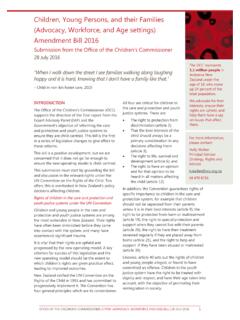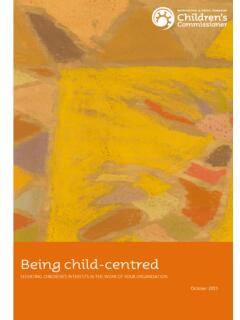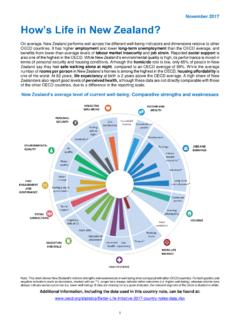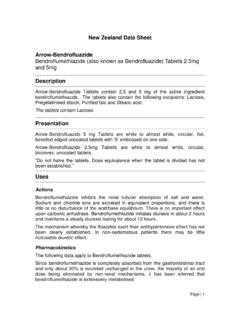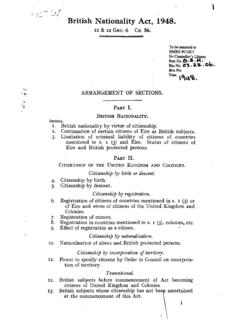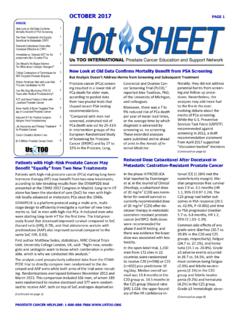Transcription of Measuring child poverty in New Zealand - Office of …
1 Measuring child poverty in New Zealand : Issues and practicalities Crown copyright . This work is licensed under the Creative Commons Attribution New Zealand licence. You are free to copy, distribute, and adapt the work, as long as you attribute the work to Statistics NZ and abide by the other licence terms. Please note you may not use any departmental or governmental emblem, logo, or coat of arms in any way that infringes any provision of the Flags, Emblems, and Names Protection Act 1981. Use the wording 'Statistics New Zealand ' in your attribution, not the Statistics NZ logo. Liability While all care and diligence has been used in processing, analysing, and extracting data and information in this publication, Statistics New Zealand gives no warranty it is error free and will not be liable for any loss or damage suffered by the use directly, or indirectly, of the information in this publication.
2 Citation Statistics New Zealand (2012). Measuring child poverty in New Zealand : Issues and practicalities. Paper prepared for the Expert Advisory Group on Solutions to child poverty . Contact Statistics New Zealand Information Centre: Phone toll-free 0508 525 525. Phone international +64 4 931 4610. Contents 1 Executive summary .. 4. 2 5. 3 The concern about child poverty and how to measure it .. 6. 4 International experience in the measurement of poverty .. 7. United States .. 7. Canada .. 8. Australia .. 9. The European 10. United Kingdom .. 10. Republic of Ireland .. 11. Summary of international experience .. 11. 5 Establishing a measurement system for understanding the well-being of children.
3 13. 6 Current situation of official statistics about 15. 7 Developing indicators of children experiencing 16. 8 Statistical issues with Measuring child poverty .. 18. 9 Options for reporting child poverty in New Zealand .. 19. Statistics NZ's possible role in producing and reporting on child poverty measures .. 19. Possible role of other government agencies .. 19. 10 Analysis of child poverty .. 21. 11 Conclusion .. 22. 12 23. 3. 1 Executive summary This paper discusses issues and practical considerations associated with Measuring and reporting child poverty in New Zealand . Its purpose is to inform the work of the Expert Advisory Group on Solutions to child poverty .
4 The well-being of children is a government priority. The government recently announced 10 priority areas to focus government activity over the next 3 5 years, three of which relate to vulnerable children. It has also announced the annual publication of a new report on the status and well-being of New Zealand families and the release of a White Paper on Vulnerable Children in October 2012. child poverty is of concern because it has an adverse impact on the life chances of children. Because child poverty is concentrated among particular sub-groups of the population, it also raises issues of social justice and equity. International experience shows that the measurement of child poverty is complex.
5 In addition to conceptual and practical difficulties, it entails making arbitrary judgements and choices that require a process of public consultation and political consensus. Statistics New Zealand currently publishes a range of statistics on the economic well- being of New Zealanders. These include statistics on the distribution of income, consumption, deprivation, and net worth. These statistics are currently used by the Ministry of Social Development to report on trends in indicators of inequality and hardship in the New Zealand population, including children. As leader of the Official Statistics System, Statistics NZ will continue to work with other agencies to develop a more coordinated and coherent measurement system on the well- being of children.
6 We are also open to adding a child dimension to the current range of outputs where possible. The Expert Advisory Group on Solutions to child poverty has recommended that their proposed core set of child poverty measures be reported annually. Some of the measures are already reported in the Ministry of Social Development's report on Household Incomes. Given the ministry's expertise in reporting on inequality and hardship, it would seem prudent for it to continue this role and to extend its measures to include the EAG's full set of child poverty measures. Summary measures of child poverty are useful in monitoring the numbers and characteristics of children experiencing material hardship.
7 To inform policy development, the measures need to be accompanied by in-depth analyses of the causes and consequences of child poverty , and the potential impacts of different policy options. Internationally, these analyses are often undertaken by research organisations. 4. 2 Purpose This paper discusses issues and practical considerations associated with the production of statistical information on child poverty . Its purpose is to inform the work of the Expert Advisory Group (EAG) on Solutions to child poverty , which was established by the Children's Commissioner in March 2012 to identify solutions to child poverty in New Zealand . The recommendations of the EAG will be used to provide advice to the Ministerial Committee on poverty .
8 Statistics NZ was invited by the EAG to prepare this discussion paper. The paper begins with contextual information on why child poverty and its measurement are of concern in New Zealand . This is followed by a broad overview of country experiences in the measurement of poverty . The next two chapters discuss key elements of a measurement system on child poverty and issues in the development of statistical measures. This leads to an analysis of what agency is best placed to report on child poverty in New Zealand . Following this is a discussion of some specific issues associated with the measurement of child poverty in New Zealand . The paper concludes by highlighting the importance for public policy purposes of complementing summary measures of child poverty with in-depth analyses to understand the causes and consequences of child poverty .
9 5. 3 The concern about child poverty and how to measure it child poverty and its measurement are attracting increasing interest in New Zealand and internationally. Children are at higher risk of poverty than adults and are highly dependent on their immediate environment for the provision of their basic needs. There is a growing body of evidence showing that children who grow up in poverty are more likely to experience poorer outcomes in areas such as education and health. This disadvantage has been shown to continue into adulthood and has also been linked to the accumulation of inter-generational disadvantage (Roelen & Gassmann, 2008; Gornick & Jantii, 2009).
10 In New Zealand , the higher risk of child poverty in M ori and Pacific communities is of concern, raising questions of social justice and equity (Henare, Puckey & Nicholson, 2011). Children from these communities will comprise a growing proportion of all children in the coming decades. In 2006, M ori children aged less than 15 years made up around 24 percent of New Zealand children and Pacific children made up 12 percent. By 2026, these figures are projected to increase to around 29 percent and 18 percent respectively (Statistics NZ, 2012). The costs of child poverty are not borne solely by those immediately affected by it. Society bears a proportion of the costs such as in the form of increased expenditure on health, and hence higher taxes and lower rates of economic growth.

